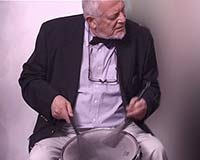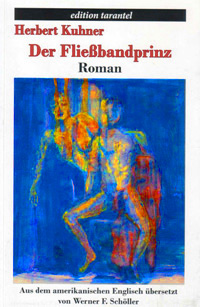-Harry`s Film Impressions (8)
Alan and the Key
The Princeton Playhouse was the home of the Technicolor A-films. The Garden Theater was the home of B-films. There were matinees of Frankenstein, Sherlock Homes, Tarzan and western films in the Garden Theater.
The Garden is still there, but the beautiful colonial-style Playhouse has gone the way of many stately Hollywood temples. It is now a parking lot.
It was at the Garden that I saw The Glass Key with Alan Ladd, Veronica Lake, Brian Donlevy and William Bendix
The Glass Key fit into the ambiance of the Garden. It was grey gloomy film noir with men in the customary trench coats and fedoras and sexy women blowing smoke in cocktail dresses or evening gowns.
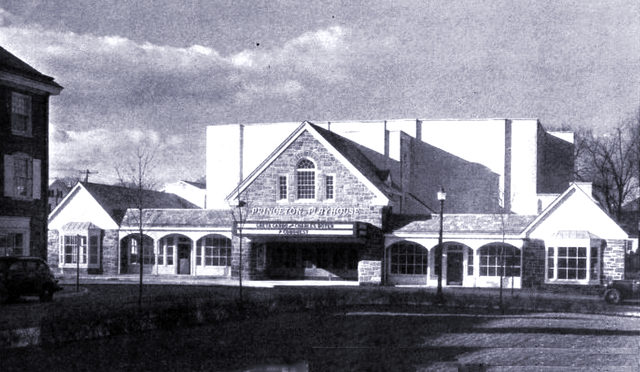
The Princeton Playhouse
Alan Ladd with the Hollywood pompadour and low voice was Brian Donlevy’s gunsel. Ladd spoke little and his silences were as effective as his sparse words.
His nemesis was wide-eyed, lantern-jawed William Bendix, the best hood ever to hit the screen. He was a Brooklyn boy gone wrong with a dazed nutty quality. There’s a scene in which he announces “I’m gonna spank baby,” and he works Alan over. That was humiliating for Alan and also for me as a viewer who’d had his share of humiliations at the hands of bullies.
But waiting for the end of the film paid off. In the denouement, Alan comes back like a beaten champion to give the usurper his just desserts, and as a prize, Alan gets slinky, peek-a-boo blonde Veronica Lake. Who could ask for anything more?
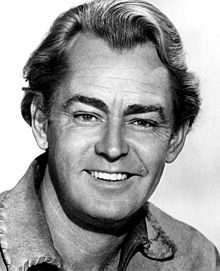
Alan_Ladd
Ladd was discovered in This Gun for Hire. That was followed by The Glass Key and The Blue Dahlia. In the first he was the perfect gangster in his quiet, threatening manner. And in the second two he was a tough guy, who was not on the wrong side of the law. In Dahlia he played a vet who comes home from the war and is falsely accused of being a murderer. Ladd’s best roles were in the noir films. Ladd left gangster-dom behind to make star vehicles for Paramount. The vehicles were not very noteworthy, with the exception of Shane, which was a critical success. But Shane was not followed up and his career went on a downswing.
When I saw Key, I was a seven-year old pipsqueak. I had my William Bendix at St. Paul’s Parochial School. I wanted to come back to best him like Ladd does at the denouement. But that never happened.
I recently rented Key at a videothèque. It brought back memories of Nassau Street, St. Paul’s and the Garden. There were scenes that I remembered clearly. They had stayed with me for decades. I didn’t get stuck on something trite. The film isn’t bad at all.
I see films on TV that I’ve seen not too long ago and completely forgotten. Viewing them is like seeing a film for the first time. Only when there’re almost over, do you sort of vaguely remember that you’ve already seen them.
Let me end with Bill Bendix. In the early days, his specialty was playing sadistic killers, and he sometimes varied by doing dazed World War II vets. But Bill the bad guy got his comeuppance. He went on to do TV sitcom. What a comedown for the man who menaced so well – ending up as a buffoon who vies for canned laughs. That fate was worse than being beaten up by Ladd.
Yankee-Doodle and the Hepcats
I saw Yankee Doodle-Dandy at the Princeton Playhouse in 1942 at the age of seven. At that age, you get just a sketch of the plot. The main thing is the images – and of course in a musical, the music sinks in. I never forgot the film, nor could I never forget the colonial style Playhouse. It was the classiest and most beautiful movie theater I have ever come upon, and it has gone the way of most of the old-fashioned movie theaters. Its ghost hovers over a parking lot.
If it had not been feasible for the Playhouse to continue as a movie theater, it would have made wonderful cultural center, art gallery or museum, but that’s all water under the bridge now, and the water keeps flowing and flowing.
Barbarians brought down the Twin Towers in New York, but Robert Moses, the city planner, and his band of cultural spoilers whisked away Penn Station. The Playhouse too, in spite of all the intellectual power gathered at Princeton University, could not be saved.
Man loves to build, but his love for destruction is greater.
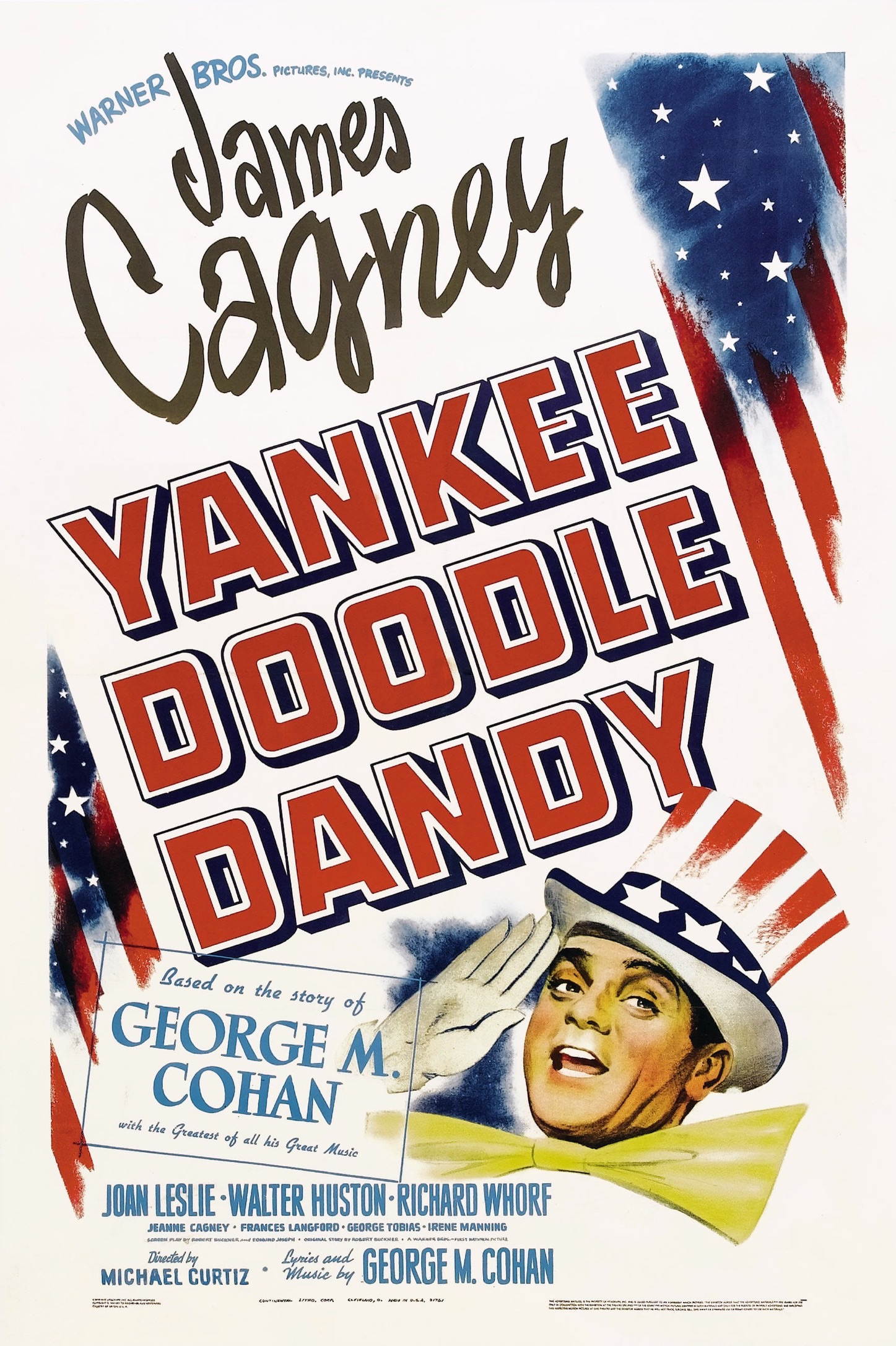
Yankee Doodle-Dandy
Recently I saw Yankee-Doodle on TV. I remembered it well. How could I ever forget it or the Princeton Playhouse?
Yankee-Doodle is the life of George M. Cohan in the Hollywood manner. Jimmie Cagney was Cohan, a decent guy, who had a terrific career as a composer of popular songs and musicals.
The music and the spirit of the film is real American hoopla in the good old flag-waving manner. Flag waving was in order since the United States was freshly engaged in World War II. Cagney deservedly got the Oscar for his acting and singing and dancing. God was he a great bundle of energy!
He proved that in addition to playing smart-talking gangsters and determined G-men, he could excel as a good citizen. Prior to Dandy, he had s done The Strawberry Blonde with Rita Haworth. She was the blonde referred to and she’d dumbstruck him. But then who wouldn’t have been dumbstruck with Rita at the time. The enamored Cagney finds out that he’d been taken in by the character she’d been playing and that the strawberries weren’t worth the eating. So he drops his spoon and rebounds with Olivia de Havilland, who was no Rita but wasn’t that bad when she wasn’t playing sappy roles like Melanie in Gone with the Wind.
I should add that I was six when I saw Strawberry and the title song was one humdinger. It became my favorite of the time.
Anyway, back to Yankee-Doodle! Cagney razzles and dazzles as a song and dance man. Did you notice that he tap dances mostly on his toes? And he could make you reach for a hankie as well!
I described Michael Curtiz as a director who could get good juice out of bad oranges. But Yankee-Doodle was a good orange, and Curtiz served it up with just the right bit of sentimentality.
There’s a scene when Cohan, who is getting on and greying at the temples, has his days of musical hits behind him. And what happens! A convertible jalopy of hepcats breaks down near his residence and the hepcats come to ask to use his phone.
They want to know who Cohan is, and when he tells them, they don’t have an inkling of what he was about.
The hepcats give him a display of the music of the time by doing a rendition of Jeepers Creepers, which is so horrible that it is blood-curdling. The hepcats are depicted as dopes who like dopey music.
Jeepers, in my humble opinion, is a great swing novelty tune, but it is supposed to represent the crappy music of the day in the Doodle film.
George M.’s songs are of the pre-jazz or non-jazz variety and have the turn-of-the century touch. Some of them are razzmatazz, which isn’t jazz, and I can’t imagine any of them being jazzed up.
These hepcats of early Forties vintage would soon have to give way to beboppers. And if they couldn’t adjust to bop, which would soon displace swing, they’d be out of the picture
The songs and ballads of the swing era would soon give way to original bebop numbers.
Musical tastes and trends change. That’s the way it goes. The latest “in thing” is tomorrow’s old hat. There have been many old hats since James played George in 1942, but Yankee Doodle is worth remembering, no matter what the trends are. And the Princeton Playhouse is worth remembering too.
to be continued . . .
– Herbert Kuhner











 Users Today : 93
Users Today : 93 Users Yesterday : 116
Users Yesterday : 116 This Month : 209
This Month : 209 This Year : 30167
This Year : 30167 Total Users : 211972
Total Users : 211972 Views Today : 564
Views Today : 564 Total views : 1937346
Total views : 1937346 Who's Online : 1
Who's Online : 1
